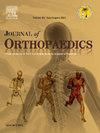Ghrelin suppresses apoptosis and autophagy in osteoarthritis synovial cells by modulating the ADORA2B/PI3K/Akt/mTOR signaling pathway
IF 1.5
Q3 ORTHOPEDICS
引用次数: 0
Abstract
Given the pivotal role that apoptosis and autophagy play in the pathogenesis of osteoarthritis (OA), the current study aims to examine the regulatory effects of ghrelin on these processes via the ADORA2B/PI3K/Akt/mTOR signaling pathway. Serum levels of ghrelin were measured in both OA patients and healthy controls using an ELISA kit. Cell proliferation was evaluated through the Cell Counting Kit-8 (CCK-8) assay, while Western blot analysis was utilized to determine the expression levels of autophagy-related proteins (LC3II/I, BECLIN-1) and apoptosis markers (BAX, Bcl-2), as well as to assess the activation status of the PI3K/Akt/mTOR signaling pathway in OA synovial cells. These analyses were performed under conditions of ADORA2B and mTOR silencing, as well as in control settings. The results revealed that ghrelin expression was significantly reduced in the serum of OA patients. Furthermore, ghrelin was found to enhance synovial cell proliferation while simultaneously inhibiting apoptosis and autophagy, as evidenced by lowered expression levels of LC3/I, BECLIN-1, and BAX, alongside an increase in Bcl-2 expression. This modulation occurred through the regulation of the PI3K/Akt/mTOR signaling pathway mediated by ADORA2B. These findings underscore the role of ghrelin in the progression of osteoarthritis by influencing synovial cell activity through the ADORA2B/PI3K/Akt/mTOR pathway, thus laying the groundwork for investigating targeted therapeutic strategies in clinical practice.
求助全文
约1分钟内获得全文
求助全文
来源期刊

Journal of orthopaedics
ORTHOPEDICS-
CiteScore
3.50
自引率
6.70%
发文量
202
审稿时长
56 days
期刊介绍:
Journal of Orthopaedics aims to be a leading journal in orthopaedics and contribute towards the improvement of quality of orthopedic health care. The journal publishes original research work and review articles related to different aspects of orthopaedics including Arthroplasty, Arthroscopy, Sports Medicine, Trauma, Spine and Spinal deformities, Pediatric orthopaedics, limb reconstruction procedures, hand surgery, and orthopaedic oncology. It also publishes articles on continuing education, health-related information, case reports and letters to the editor. It is requested to note that the journal has an international readership and all submissions should be aimed at specifying something about the setting in which the work was conducted. Authors must also provide any specific reasons for the research and also provide an elaborate description of the results.
 求助内容:
求助内容: 应助结果提醒方式:
应助结果提醒方式:


